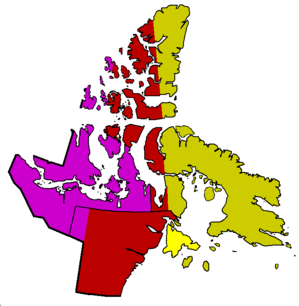Time in Nunavut
This article includes a list of references, related reading, or external links, but its sources remain unclear because it lacks inline citations. (January 2014) |

| Standard | DST | ||
|---|---|---|---|
| GMT−05:00 | GMT−04:00 | Eastern Time | |
| GMT−05:00 (year round) | Eastern Time | ||
| GMT−06:00 | GMT−05:00 | Central Time | |
| GMT−07:00 | GMT−06:00 | Mountain Time | |
Nunavut is divided into three time zones, Eastern, Central and Mountain.
Mountain Standard Time
- Mountain Standard Time MST UTC−7
- West of 102° West and
- all communities in the Kitikmeot Region
Central Standard Time
- Central Standard Time CST UTC−6
- Between 85° West and 102° West (except western Southampton Island [citation needed])
- (Resolute, Repulse Bay, Baker Lake, west shore of Hudson Bay)
Eastern Standard Time
- Eastern Standard Time EST UTC−5
- East of 85° West* (Sanikiluaq, Cape Dorset, Hall Beach, Igloolik, Arctic Bay, Grise Fiord and all points east), and
- most [citation needed] of Southampton Island (no daylight saving time) (Coral Harbour)
History
When the territory was created in 1999, the new government believed a unified time zone would make it easier for its citizens to conduct business. Public hearings noted there was support for this idea, although disagreement as to which time zone to observe. The territorial government announced that effective October 31, 1999 all clocks would change to Central Standard Time. Iqaluit, the capital located in the far eastern edge of the Eastern time zone, was unhappy with this decision. The city council voted against the measure and vowed to keep the city on Eastern time. As late October 1999 approached the city council backed down and agreed to accept the change to Central time "in the spirit of working with the Nunavut government". They agreed to review the decision in six months.
After hearing complaints from a number of communities in late 1999 and early 2000 the government modified the time zone. They announced the territory would now be on Eastern Standard Time year round, daylight saving time would no longer be observed. The change would be effective October 29, 2000. Many western communities supplied from the south by communities on Mountain time felt this put them too much out of sync with their neighbours. After some debate it was decided the far western communities would be allowed to change back to Central time on November 4, 2000. However they would observe daylight saving time in the summer. This would unify Nunavut with one time in the summer and keep western communities a constant one-hour difference from their southern neighbours.
By April 2001 this plan was abandoned. Nunavut reverted to the three previous time zones it inherited from the Northwest Territories administration of the region. The only region to remain on Eastern Standard Time (without DST) as planned was Southampton Island, but with the exception of a small western portion of the island which is on Central Time year round.
